The Madagascar Palm tree has a barrel-shaped stem that is completely covered with spikes like many cacti, but it is also not a cactus. This striking plant is actually a succulent and thanks to tropical foliage, it looks like a desert cactus.
Learn how to grow it and care for the Madagascar palm in this plant guide.
Madagascar Palm Overview
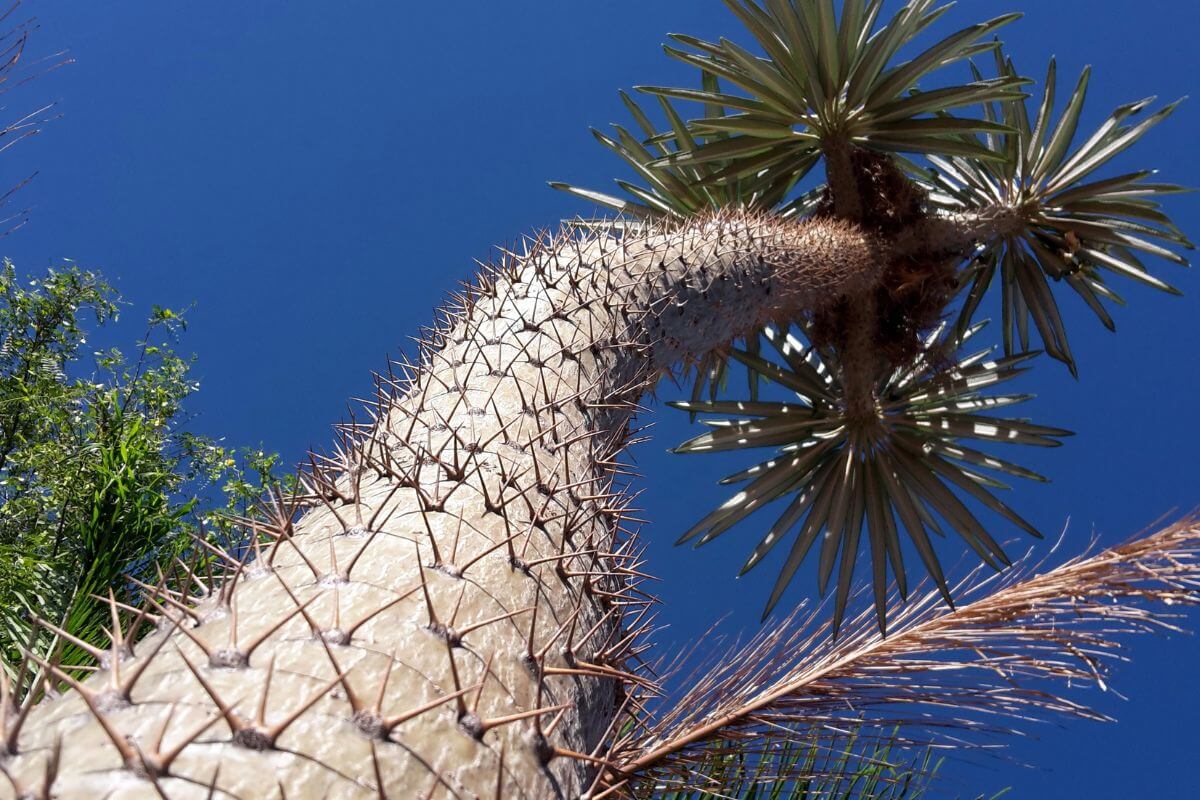
The Madagascar palm, as its popular name suggests, is a native of the African island of Madagascar. This plant is also called by other unusual names, including:
- Ghost Men Plant
- Pachy
- Summer-blooming clubfoot
- Three-spined clubfoot
A member of the Apocynaceae family, the Madagascar Palm, known botanically as the Pachypodium lamerei is not a palm at all.
Pachypodium signifies literally “thick foot” which is in keeping with its appearance. A stem succulent plant, photosynthesis works through the stem instead of the foliage.
Although it is native to Madagascar, it will thrive in USDA hardiness zones 9a to 11.
While this plant is often sold as a small plant without an apparent trunk, a healthy mature plant can reach heights of twenty feet tall.
A rapid grower, this palm plant can reach a height of three feet in just a few years. As the stem grows, it will also thicken and hold water reserves.
When the plant matures, it will become top-heavy with foliage, and it will need a weighted pot to avoid tipping. The shiny vivid green leaves at the top combine to make an umbrella, giving it a truly unique appearance.
In the springtime, foliage grows with leaves reaching as much as fifteen inches long and four inches wide. In winter, leaves will drop, and the cactus-like base remains until the next spring.
Occasionally, this lovely plant will produce blooms that are small and white among the leaves. Blooms have no fragrance and will only appear when the growing environment mirrors its native environment.
Flowering is rare indoors unless this plant has lots of direct sunlight.
Madagascar Palm Care Guide
Growing Medium for the Madagascar Palm
As a succulent, this plant will thrive in a cactus potting mix and a pot with drainage holes. The cactus potting mix will help with drainage and impede the development of root rot.
If you do not have a cactus mix available, two parts of regular potting mix with one part of perlite or sand will work.
Light for the Madagascar Palm
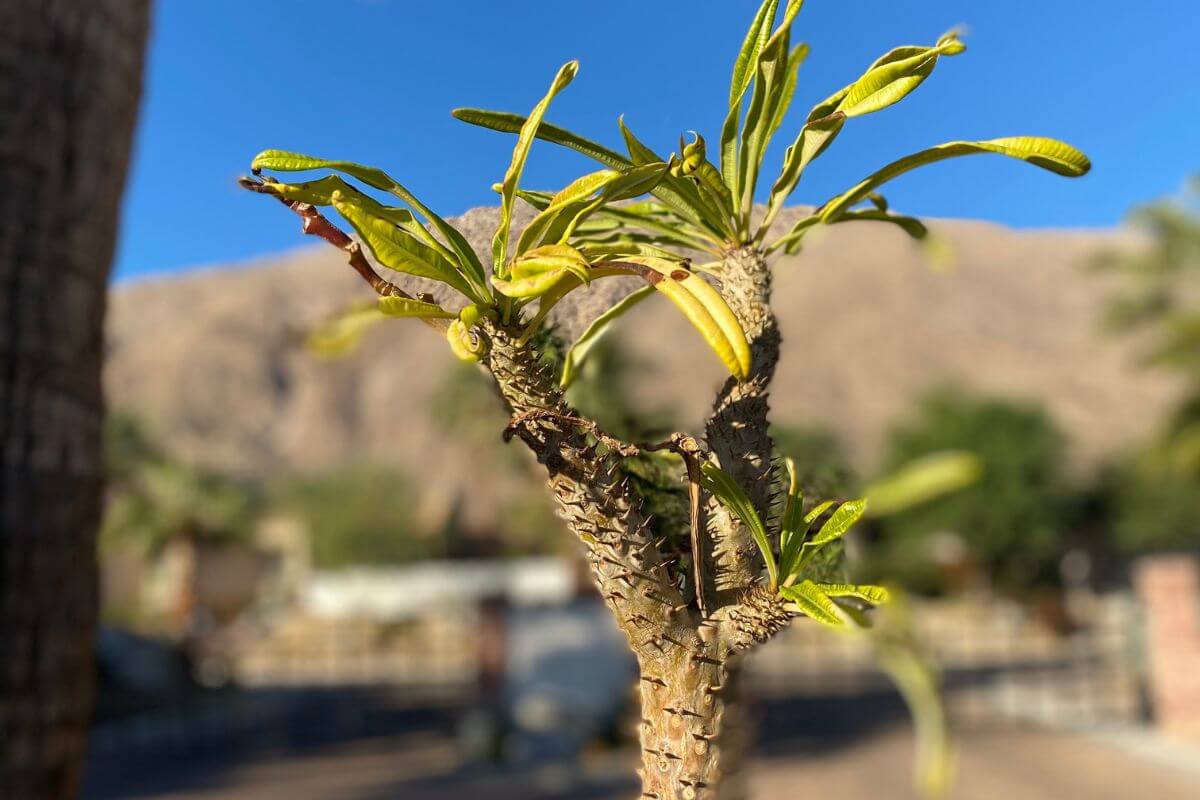
Sun lovers, these succulents want warm weather, bright light, and even some full sun.
Pachypodiums can be positioned by a south-facing window where they can receive plenty of sunlight.
Water and Humidity for the Madagascar Palm
Your Madagascar palm can be kept on the dry side, so it’s drought-tolerant. It should be watered only if the soil bed has dried out. If you overwater a shedding plant, you may kill it. When new foliage appears, you can resume watering.
Abundant watering is appropriate in the spring and summer months with warm temperatures. In the winter, watering needs to be reduced. When the foliage drops, interrupt the watering.
A humidity level of approximately 40% is adequate.
Temperature for the Madagascar Palm
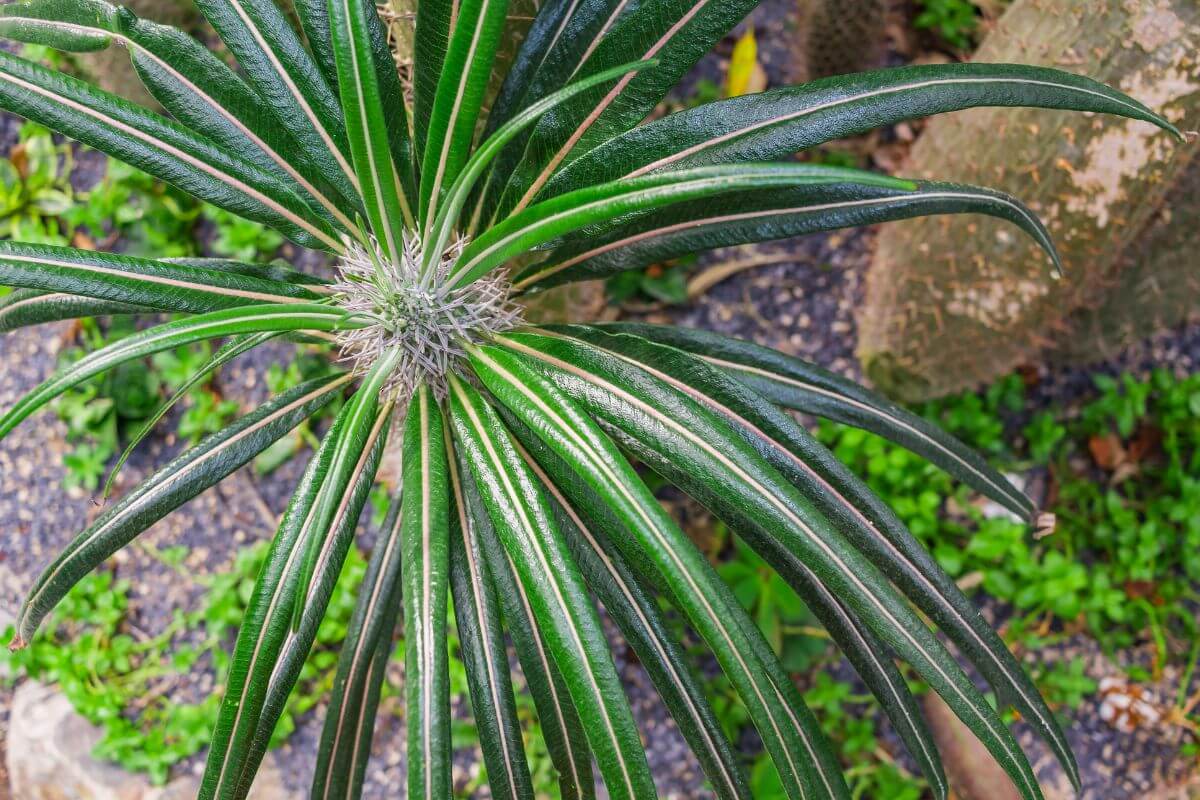
This is a sun-loving plant that does well in warm weather. Temperatures between 65° and 75° Fahrenheit are best.
If you’re growing it as an outdoor landscape plant, it’s important that they are not located in a place where temperatures fall below 55° F.
In fact, in the winter months, this is one of few plants that will be happy when placed near a heating vent. If your Madagascar palm remains warm during the winter, it may still retain its foliage.
Fertilizer for the Madagascar Palm
Your Madagascar palm can be fed with fertilizer at the beginning of the spring and summer. Use a liquid succulent fertilizer when your palm is in the growing season, during the warm months.
Pruning and Repotting the Madagascar Palm
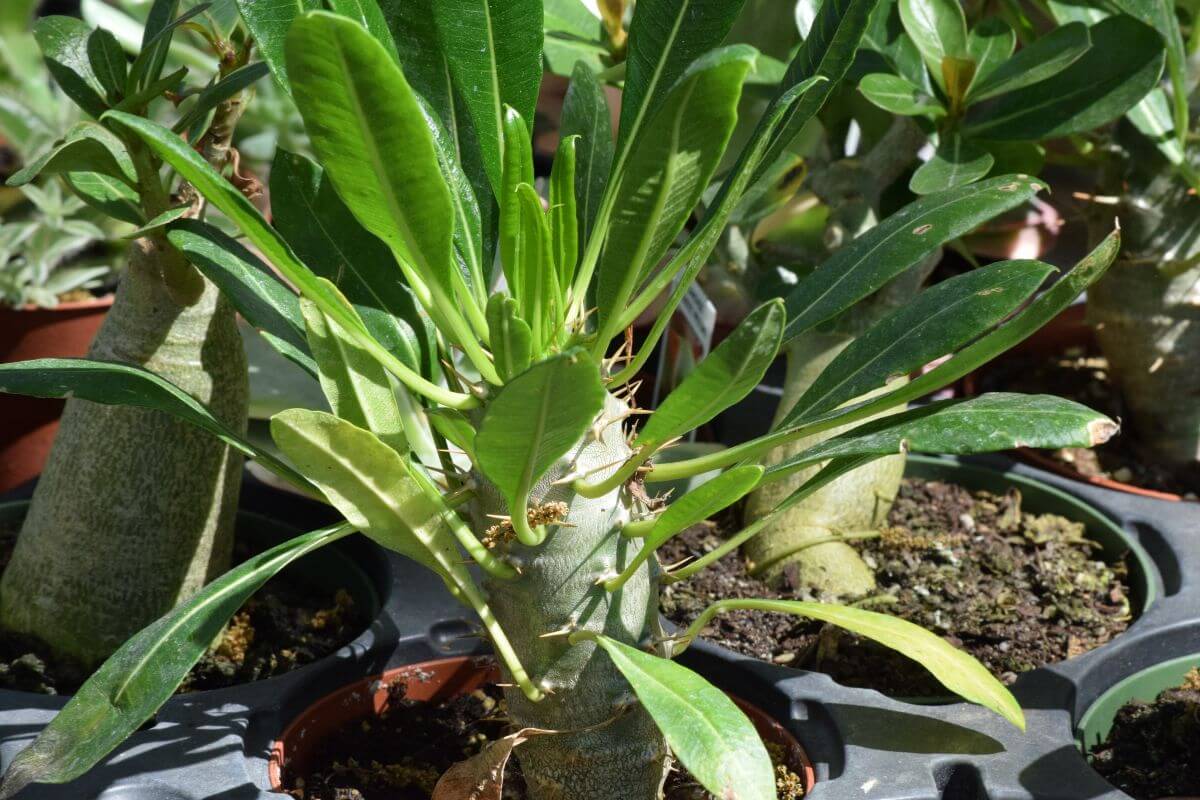
The only pruning necessary is for the removal of dead leaves.
The Madagascar palm can be repotted every three to four years when it is apparent that it has outgrown its pot.
Weighted or clay pots are recommended to avoid toppling by these top-heavy succulents. Use all necessary precautions when repotting, as the spines on its spindly trunk are sharp and dangerous.
Propagating the Madagascar Palm
The Madagascar palm can be propagated through seeds or offsets that are purchased or taken directly from your plant. Propagation with seeds will be tougher because they do not germinate well.
To propagate with seeds:
- Place them in warm water for 24 hours.
- Afterward, plant the seeds in the sand that is moist and keep them in a location that has a normal room temperature.
Offsets can readily be collected from your palm. Look for small cacti that are ball-shaped positioned near the trunk. You should find them just below the foliage of the plant. Break these off the plant and set them aside to dry out for approximately a week.
Place the dried offsets in individual containers with a soil bed that is three parts sand and one-part potting mix. Plants should be located in a warm room until the roots develop. Leaves may die back, but once the roots form, foliage growth should resume.
Madagascar Palm Pests, Diseases, and Problems
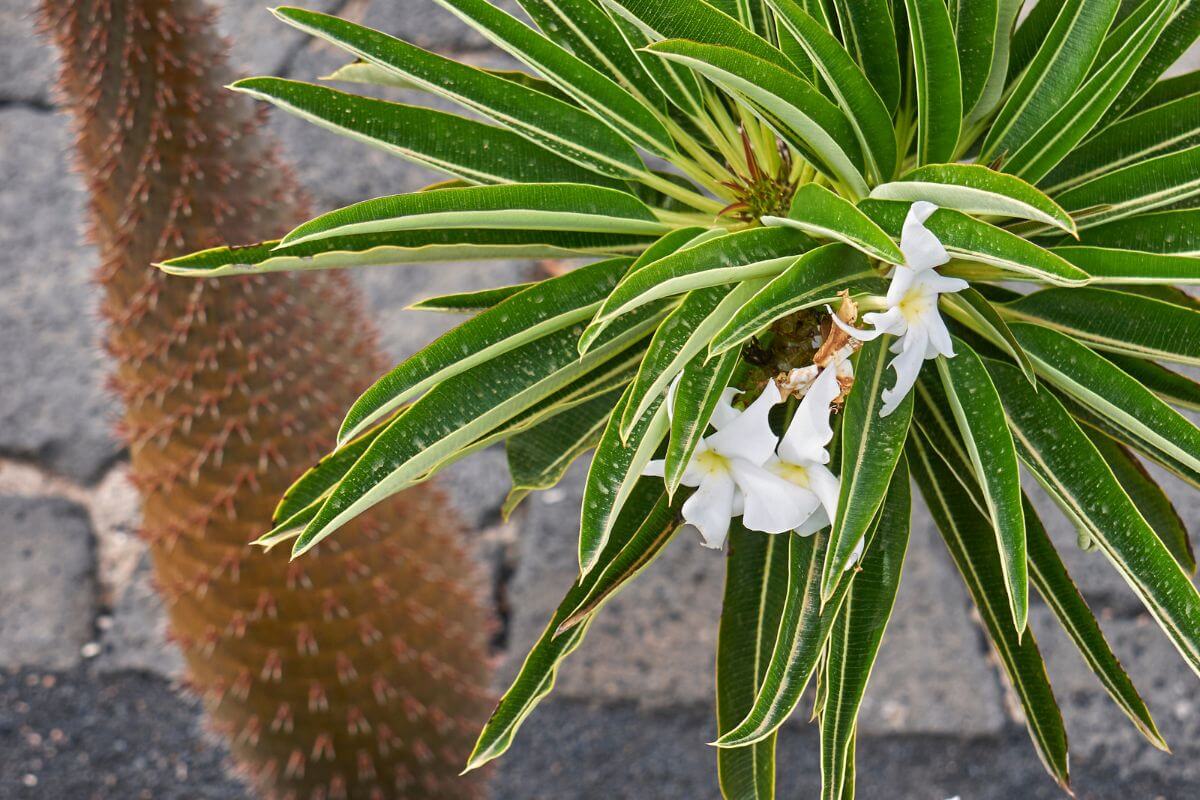
Whiteflies and spider mites find this palm inviting. Check the undersides of the foliage for pests. If you see any, use an organic insecticide like neem oil to rinse off infected foliage.
- Related Article: Organic Pest Control Guide
The most important threat to this succulent is overwatering that can lead to root rot. Both succulents and cacti do not like excessive watering as their trunks already contain water reserves.
When the Madagascar palm is suffering from overwatering, the plant’s trunk may snap in half. This may also happen when the hosting environment is too cold, or the plant is not receiving sufficient light.
If the plant breaks, it cannot be saved. If the trunk bends without breakage, you can attempt to save it by repotting it with a mix of soil and sand with minimal watering to see if it revives.
If you forget to water your plant for a period of time and it’s underwatered, it will experience leaf drop in summer as opposed to winter.
Yellow leaves indicate a lack of nutrients and your plant could use some fertilizer.
Madagascar Palm Toxicity and Pets
Madagascar palms are considered poisonous to cats, dogs, and humans due to toxic sap. Plus, the pointed spikes can penetrate the skin creating health problems.
If you suspect ingestion of a palm part or spike penetration, contact your veterinarian or poison control center immediately.
Madagascar Palm Care Final Thoughts
The Madagascar palm is easy to care for and maintain. It requires little maintenance other than occasional fertilization and regular mistings during hot weather. The only real problem is overwatering, which leads to root rot.
For more palm trees and houseplants, check out these care and grow guides:
- Kentia Palm Tree Care Guide
- Lady Palm Tree Care Guide
- Fishtail Palm Tree Care Guide
- Kangaroo Paw Fern Care Guide
- Strawberry Begonia Plant Care Guide
Madagascar Palm FAQs
How often should I water my Madagascar palm?
Water your Madagascar palm every two weeks during the growing season. Water deeply at least twice per month. The soil type should be a well-draining potting mix, so you can water whenever you notice the top couple inches of the surface soil are dry.
How much sun does a Madagascar palm need?
Your Madagascar palm needs bright sunlight throughout its life cycle, including full sun. During spring and early summer, direct sun exposure is best for optimal growth.
How big does a Madagascar palm get?
The Madagascar palm can grow up to 20 feet tall and wide when grown outdoors in its native environment. However, they usually reach about 5–6 feet high and 3–4 feet across when grown indoors.
Are Madagascar palms poisonous?
Yes, Madagascar palms are poisonous because of the toxic sap. Keep your pets and small children from chewing and eating the parts of the leaves.
Why is my Madagascar Palm dying?
There could be a number of reason your Madagascar palm is dying. First, make sure there isn’t any disease present on the plant. Next, look closely at the roots and surrounding area for signs of insect infestation. Finally, consider whether the plant has been overwatered or neglected.
What kind of soil should I put my Madagascar palm in?
You want to choose an indoor container that drains very well. You don’t have to worry about drainage issues while planting your Madagascar palm outside since it grows naturally in tropical climates.
How do you get Madagascar palms to bloom?
To encourage blooms on the Madagascar palm, give them plenty of sunlight and water regularly. If you’re not getting flowers after several months, try repotting into fresh medium with new plants. Also, keep the temperature around 70 degrees Fahrenheit during this time.


